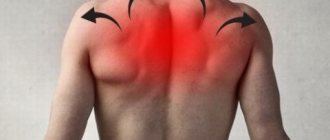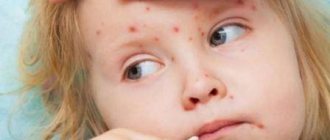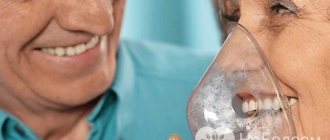When the airways are normal, the child breathes silently and effortlessly. When their patency is impaired, a high-pitched sound may appear when breathing, as air passes through the narrowed breathing tubes with effort. Wheezing is the sound that occurs when a child inhales and exhales through narrowed airways. Airway obstruction can occur due to swelling caused by infection, foreign body, inflammation and spasm of the bronchial muscles in asthma. Sometimes a rough wheeze is heard only when inhaling: this may be a symptom of croup. This wheezing is called stridor (see Help for croup).
URGENT CARE
Call emergency services for your child if wheezing is accompanied by:
- difficulty breathing
- The child has blue skin around the lips
- unusual drowsiness, lethargy
- inability to speak or make normal sounds
ATTENTION!
Wheezing in a child may appear suddenly when a foreign body enters the respiratory tract. Minor wheezing may be accompanied by ARVI. If you experience wheezing when breathing, consult a doctor immediately.
| ASK YOURSELF A QUESTION | POSSIBLE REASON | WHAT TO DO |
| Does your infant have fairly loud wheezing only when he or she inhales? Is he eating and growing normally? | Norm | If the baby is eating, sleeping and growing normally, noisy breathing simply shows that the tissues in the airways are still quite elastic. Such noisy breathing should go away by 1.5 years, when the cartilage of the larynx (windpipe) becomes denser. However, pay to the child’s noisy breathing during your next examination. |
| Does your child also have a runny nose or cough? | Cold (ARVI) | Call the pediatrician . Give plenty of fluids, make the child comfortable (see also Runny nose in a child) |
| Child under one year old? Does he have a cough that lasts 2 hours or more? Has he had a cold in the last day or two? Rapid and difficult breathing? Is he refusing to eat? Irritable? | Bronchiolitis is a disease, usually viral, that affects the smallest bronchi | Call "emergency" . If the diagnosis is confirmed, hospitalization may be required |
| Does your child cough often? Do you experience episodes of difficulty breathing, especially at night or during physical activity? Does anyone in the family suffer from asthma or allergies? | Asthma | Make an appointment with your pediatrician . He will examine the child and prescribe the necessary examinations; Depending on the results, he will recommend treatment (see also If a child has asthma) |
| Does the child have difficulty breathing or suffocation? A hacking, dry cough that sounds like a dog barking; Hoarseness of voice? Fever? Are your symptoms worse at night? | Croup is difficulty breathing caused by inflammation and narrowing of the upper respiratory tract. | Although most attacks can be relieved with home remedies (see Help for Croup), if an attack begins, call A& E . Before the doctor arrives, take the child to the bathroom, close the door, run hot water into the bath to create steam, and let the child breathe in the moistened air. Place naphthyzine drops into your nose. If the condition does not improve, allow the child to breathe cool night air |
| Has your child suddenly developed difficulty breathing or wheezing? | Foreign body in the respiratory tract (most common in children 6 months to 2 years of age) | This is an emergency. Call an ambulance ; First aid measures - see Respiratory arrest) |
| Rapid breathing, wheezing, severe cough? Is your temperature elevated to 38.3 °C or more? Is your child feeling unwell? When you inhale, do the intercostal spaces retract? | Pneumonia | Urgently call a pediatrician , he will make a diagnosis and prescribe treatment. Hospitalization may be required (see Difficulty breathing, Cough) |
| Does your child snore in his sleep? Do you wake up irritated every morning? Does he breathe through his mouth often because his nose is blocked? Do you get tired quickly? Does he speak through his nose? Does he have frequent colds and ear infections? | Enlarged adenoids; allergy | Contact a pediatrician , he will examine the child to identify enlarged adenoids (see also Runny nose in a child, or allergic disease), and prescribe treatment |
FOR INFORMATION
Why wheezing is more common in young children
Wheezing is common in children under 3 years of age. Because their airways are smaller, obstruction due to spasm of the bronchial muscles, inflammation and swelling of the mucous membrane, and accumulation of secretions occurs more easily than in older children. Respiratory diseases can be caused by air pollution, including cigarette smoke. If anyone in the family smokes, you should insist that no one smoke in the house.
What is the difference between a normal cough and a wheezing cough?
Normal cough
. Strong, sharp exhalations are caused by irritation of receptors located on the entire surface of the mucous membrane of the respiratory tract. Thanks to coughing, the lumen of the respiratory organs is freed from the accumulation of mucus, foreign particles and anything that obstructs the passage of air.
But with respiratory diseases, the cough characteristics may change:
- superficial “barking” cough is often observed with laryngitis, tracheobronchitis and represents individual cough impulses, the so-called coughing;
- paroxysmal cough - a series of strong coughing impulses that can last up to several minutes, often caused by bronchitis, whooping cough or insufficient volume/high viscosity of bronchial mucus, which makes it difficult to eliminate.
Cough with wheezing
. With such a cough, regardless of its duration or intensity, distinct wheezing is heard in the chest when inhaling and/or exhaling. This sound is the result of air passing through a narrowed airway or through a buildup of mucus. In this case, wheezing can be dry (with laryngitis, tracheitis, bronchitis) or wet (with diseases accompanied by accumulation of sputum in the respiratory organs, and with friction of the walls of the bronchi against the lungs).
The wheezing itself can be whistling, bass, sonorous, or silent. They may appear only during coughing episodes or even outside of them. The combination of all the characteristics of a cough gives the doctor an idea of what kind of disease he is dealing with.
1.General information
Wheezing is a collective name for all kinds of abnormal, normally not occurring sound phenomena that accompany any phase of the respiratory cycle.
To a non-specialist, all these sound “special effects” will most likely seem like a chaotic cacophony; at best, he will be able to distinguish healthy breathing from painfully altered breathing by ear - by the presence of bubbling, gurgling, crunching (“like fresh snow underfoot,” says one of the ancient medical treatises), whistling, buzzing and other wheezing sounds. However, medicine has been studying the structure of the respiratory system, physiology, physics and acoustics of breathing for more than one millennium. An experienced therapist, otorhinolaryngologist, pulmonologist, phthisiatrician, and any other doctor, no matter what specialization he belongs to, listens to these noise phenomena, just as we listen to an audiobook on headphones today. For him, wheezing is so natural, understandable and informative that auscultation (listening) of the chest using a phonendoscope often makes it possible to establish or at least suggest a diagnosis long before the results of laboratory and instrumental studies arrive.
There are many methods and modes of auscultation: the nature of wheezing changes depending on whether the patient is standing or lying down, breathing deeply or shallowly, frequently or at long intervals - which is the reason for the well-known doctor’s instructions to the patient during auscultation. Accordingly, in medicine, many types and varieties of pathological breathing are distinguished, not only by frequency and depth, but also by the acoustic characteristics of auscultatory noises.
Sign up for a consultation
A must read! Help with hospitalization and treatment!
What diseases cause cough with wheezing?
The list of diseases that cause coughing and wheezing in the chest is quite extensive. But the most common causes of this symptom include the following:
- laryngitis
– inflammation of the mucous membrane of the larynx, in which its lumen narrows due to swelling, can cause wheezing during inhalations or exhalations, or when coughing;
- tracheitis
– inflammation of the tracheal mucosa; in advanced cases, dry wheezing may be observed;
- pharyngitis
– inflammation of the mucous membrane of the pharynx can quickly spread to the underlying organs of the respiratory system, which will cause wheezing in the chest when coughing;
- bronchitis
– inflammation of the bronchial mucosa, quite often accompanied by a cough, which is followed by wheezing some time after the onset of the disease;
- allergy
– upon contact with an allergen, the respiratory organs may react with inflammation and swelling. This narrows the airway, which can cause wheezing when coughing;
- bronchial asthma
is a chronic inflammation of the respiratory tract, in which periodic narrowing of the lumen of the bronchi and the release of large amounts of mucus are observed. During such attacks, shortness of breath and wheezing appear, caused by obstructed air circulation.
Essentially, any infectious or inflammatory disease of the respiratory tract can cause a cough with wheezing if not treated promptly. This leads to a deterioration in the removal of mucus, its thickening and the formation of a mechanical obstacle to inhaled and exhaled air. Doctor MOM® cough syrup and lozenges help relieve inflammation and relieve cough. Early treatment can avoid a number of complications and speed up recovery.
3. Symptoms and diagnosis
There are, as stated above, many types of wheezing. Thus, dry noise with a high whistle is characteristic of diseases and obstructions that occur without copious secretion and accumulation of sputum, while lower, buzzing overtones are heard in the presence of thick exudate in the bronchi. In general, dry wheezing is found in asthma, cancer processes, COPD (chronic obstructive pulmonary disease and its exacerbations), laryngitis, pharyngitis, bronchitis, and foreign bodies.
Moist rales (among which small-, medium- and large-bubble rales are distinguished) in various subtypes are characteristic of pulmonary tuberculosis, abscess processes with purulent-inflammatory melting of tissue, bronchiectasis, pneumonia, pulmonary edema and other diseases that cause a massive accumulation of flowing, non-viscous fluids.
Crepitation - sounds like crunching, crackling, cellophane rustling, etc. - is formed when inflamed alveoli and bronchioles stick together/unstick, where a small amount of exudate accumulates (lobar pneumonia in the initial stage and the resolution stage). There is also a “fibrous crackle” on inspiration, characteristic of alveolitis in the scarring stage, and “pleural friction” with fibrosing chronic inflammation, tuberculosis or pleural tumors.
Depending on the nature of the pathological process, auscultatory wheezing may be accompanied by a cough of one type or another, chest pain, low-grade fever or febrile body temperature, weakness, general malaise, hyperhidrosis, shortness of breath, etc. In some cases, changes in the acoustics of breathing (bubbling, dry whistling, the actual hoarse component) are clearly audible to the “naked ear” at a distance.
As for diagnostics, the main tool in this context for two hundred years has been the stethoscope (stethophonendoscope), a repeatedly modernized sound-conducting tube.
About our clinic Chistye Prudy metro station Medintercom page!
When do you need to see a doctor urgently?
Coughing and wheezing when breathing may indicate the onset of a serious illness. If you have such symptoms, it is very important to seek qualified help from a doctor. This is especially important if the cough with wheezing is accompanied by one or more of the following symptoms:
- release of large amounts of sputum;
- change in the consistency and/or color of sputum (watery, excessively thick, with inclusions of pus, streaks of blood, etc.);
- constantly increased or decreased body temperature;
- weight loss not associated with changes in diet;
- night or excessive sweating.
Considering that wheezing during coughing can be symptoms of a wide variety of diseases, you should in any case consult a doctor. Only a qualified specialist can make an accurate diagnosis and recommend how to treat the identified disease.
Diseases of the cardiovascular system and wheezing in the chest
Congestion in the pulmonary circulation leads to leakage of lymph into the chest cavity. The barrier to air flow in these situations is the accumulated liquid, which also prevents the lungs from expanding for a full breath. The breathing of such patients can be heard from neighboring rooms.
The most common diseases of the cardiovascular system, in which wheezing appears in the chest when inhaling:
- Chronic heart failure. It is formed against the background of arterial hypertension, angina pectoris, heart defects, COPD, asthma. Treatment includes the prescription of diuretics, beta blockers, ACE inhibitors, potassium and magnesium supplements.
- Pulmonary edema, including due to a heart attack. Dangerous condition requiring resuscitation measures.
- Congenital or acquired heart defects. The former are caused by improper formation of the organ during intrauterine development, the latter are caused by bacterial and viral agents, pericarditis, and rheumatism. The main principle of treatment is surgical. The valves are replaced with artificial ones, and the open oval windows are sutured. Many patients receive supportive care.
Edema of the left lung on x-ray (on x-ray the left lung is on the right)
How to treat cough with wheezing?
What to do when you have a cough with wheezing, as mentioned above, depends on the disease that caused this symptom. After a comprehensive examination and diagnosis, the doctor may prescribe several drugs from different drug groups.
Antibiotics
.
Prescribed for diseases caused by pathogenic bacteria. Antibacterial drugs inhibit the vital activity of these microorganisms and cause their death, but should be selected only by a doctor and solely taking into account the sensitivity of microbes to certain drugs. Antihistamines
.
This group of medications is prescribed for cough and other respiratory, skin, or gastrointestinal symptoms caused by allergies. Also, antihistamines can be part of a complex of drugs prescribed for acute respiratory viral infections. Bronchodilators
.
This group of drugs is recommended for coughs with wheezing, which are caused by a narrowing of the lumen of the bronchi. They help normalize breathing, eliminate shortness of breath, and restore the function of removing mucus from the bronchi. This group of drugs has different mechanisms of action, so the specific drug should be selected by the attending physician based on the characteristics of the situation. Mucolytic
.
These agents thin the mucus and prevent it from settling on the walls of the bronchi. This facilitates the removal of both mucus itself and pathogenic microorganisms and toxic products of their vital activity. Doctor MOM® syrup and herbal cough lozenges have pronounced mucolytic and bronchodilator effects, which are based on the action of a complex of medicinal plants. Antipyretics
. They can be recommended for elevated body temperature. An integrated approach to the treatment of cough with wheezing of any origin is important, since it is only one of the symptoms of the disease.
Classification
According to the nature of their manifestation, wheezing in the lungs can be:
- dry;
- wet;
- whistling;
- crepitus is a sound that is similar to crunching or crackling.
In turn, wet noises are divided into:
- finely bubbled;
- medium bubbly;
- large-bubbly.
In addition, there are several other divisions of this symptom:
- by tonality – high and low;
- by homogeneity - homogeneous and heterogeneous;
- by timbre – polyphonic and monophonic;
- by prevalence;
- by sonority - sonorous and muffled;
- by quantity - single and multiple.
Classification of wheezing
It is these factors that the pulmonologist pays attention to during a physical examination during diagnosis.
Doctor MOM® preparations for the treatment of cough with wheezing
Doctor MOM® preparations are prescribed as a means of complex therapy for infectious and inflammatory diseases accompanied by cough. Included in the herbal cough lozenges “FITO BRONHO formula”1 and syrup “FITO BRONHO 10 formula”2 helps fight the cause of cough - inflammation, and also thins the mucus in the bronchi and facilitates its elimination. To eliminate symptoms such as headache and muscle pain, you can use Doctor MOM® Phyto ointment. It contains extracts of 4 essential oils, thanks to which the ointment has an inhalation effect3, as well as a warming4 effect, which helps relieve unpleasant symptoms.
Treatment
Elimination of inspiratory wheezing is, first of all, aimed at eliminating the underlying ailment that led to the fact that a person can hear wheezing when taking a deep breath. The treatment regimen may include both conservative and surgical techniques.
To get rid of the symptom itself, use:
- medicines;
- physiotherapeutic procedures aimed at warming the chest;
- folk remedies.
Drug therapy includes taking:
- mucolytics - to thin sputum, if present;
- bronchodilators - to improve the passage of air through the respiratory tract;
- antibiotics;
- expectorants.
An excellent way to get rid of wheezing when inhaling are inhalations using essential oils, as well as those made on the basis of:
- lemon balm or propolis;
- coltsfoot;
- calendula and chamomile;
- St. John's wort and mint;
- marshmallow and lemon balm;
- horsetail and licorice.










